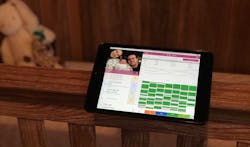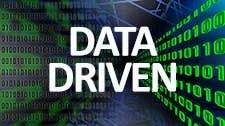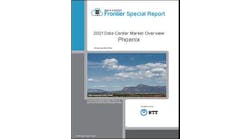Today we continue “Data Driven,” a series of articles examining the volume of data generated by emerging technologies, with a look at how embedded data unexpected sources – like newborn babies – quickly contribute to the streams of information filling data centers.
Our newborn just turned 4 weeks and there’s a reality that’s setting in: Our baby has a pretty big digital footprint already.
Let’s start here, I’m a new dad and I’m learning a lot! For any parent reading this, the first few weeks have been challenging, but also amazingly enlightening and full of love.
I should add that I am a millennial, and that raising a child today is a little different than my parents’ experience. If you’ve read my blogs here in the past, you’ll also know that I’m a big techie anthrd absolutely love leveraging new technologies to make life (and business) easier. To that point, I’ve quickly learned the saying “There’s an app for that” can literally extend to almost every single aspect of our lives – including raising a baby.
Before we go on, it’s important to understand just how much data we’re creating and how many new devices are connecting into our businesses and lives. According to a report by IDC, by 2025, embedded data will constitute nearly 20% of all data created — three quarters the size of productivity data and closing fast. Productivity data comes from a set of traditional computing platforms such as PCs, servers, phones, and tablets. Embedded data, on the other hand, comes from a broad variety of device types, including baby monitors, smart toys, wearables, and so on.
The IDC report predicts that the average rate per capita of data-driven interactions per day is expected to increase 20-fold in the next 10 years as our homes, workplaces, appliances, vehicles, wearables, and implants become data enabled. All these embedded devices will radically increase the average person’s level of interaction with data, changing the user experience.
Here Come the Apps!
Like being a new dad. When we had our baby girl, I turned to data and the cloud for help. Aside from Googling almost every single question that came to mind at 3 a.m., I employed a number of apps, smart devices, and new tools to help raise our child. And, four weeks in, I have to say that the power of data and the patterns we can leverage have been nothing short of amazing.
Let me give you some perspective. To track almost every single aspect of our daughter’s life, we use an app called Baby Tracker. I can’t begin to tell you how important it is to leverage the power of data, especially when your brain isn’t entirely working. We never have to guess when she slept, when a diaper was changed, and even when we should lay her down to sleep. Most of all, this data allowed us to chart and see patterns. What does that mean? She was sleeping 3-4 hour stretches at night by the fourth day. We were able to wake her effectively, feed, change, burp, and put her right back to sleep!
We knew when she needed to eat, how long she needed to be awake, and when the best time to lay her down would be. All of this results in a baby that cries less, gets her needs met, and – of course – happier parents.
Several screens of data from BabyTracker, illustrating the many variables that can be recorded and tracked. (Images: Bill Kleyman)
We also use a smart baby camera called Nanit. Yes, it’s on the pricier side, but it’s absolutely worth it. This little device is not only super secure (we’ll touch on that later), it also provides very valuable sleep insights. Is the baby getting a good amount of sleep? How many times does she move around, and how does this compare with other children with her similar metrics. In fact, their Insights feature transforms the already awesome video baby monitor into an intelligent sleep guru with advanced cloud algorithms. Sleep tracking, sleep efficiency, sleep onset, and even sleep coaching based on your analytics are all included. Plus, the temperature and humidity sensors allow you to constantly keep track of a comfortable baby.
An image from the Nanit smart baby camera, which also provides insights to sleep patterns. (Image: Bill Kleyman)
At first, I honestly thought that all of this data would be overwhelming and we’d be spending way too much time looking over it. However, today’s data analytics tools are specifically designed to make analyzing patterns and look at data points fundamentally easier. Whether you’re tracking your fitness, raising a child, or embarking on a big data journey – the biggest piece of advice is to leverage tools designed to make life easier.
The Power of Data and Patterns
Looking beyond baby apps and tools, we are constantly creating a deluge of data. You can even apply some of these principles into improving your data center and your business environment. The bottom line: make sure you are leveraging tools which make data analysis easier.
However, your participation is required and good, clean data is an absolute requirement. In the case of our baby, if we just leave data entry to the end of the day and not when an event happens, this information will be much dirtier and much less helpful. It’s critical that you input data in real-time to make it highly useful.
That said, your tools must allow you to analyze data and even inform you when various types of patterns are happening. This data utilization isn’t only real-time, it’s now proactive and helping you make better decisions.
I honestly couldn’t think of a better example of leveraging data than when working with a newborn. Situations can be highly stressful, you’re sleep deprived, and your brain is on overdrive. Having a reference point to help you make sense of various events is extremely useful.
It’s been enlightening to see various types of data patterns around the growth of our baby, including everything from the number of feedings to the growth she’s experiencing. We can input, literally, any data point and track the respective progress to make sure everything is on track. We can gauge how much she’s growing per day, how much she’s taking in per feeding, and how effective her sleep patterns are. If you’re a new parent (or are planning on becoming one), don’t be afraid to leverage the power of applications and data to make your life easier; and have a happier baby.
To that extent, let’s pivot and discuss an important topic: Keeping that data safe.
Data Privacy, Security, Custody and the Cloud
As you can imagine, this part is really important. My biggest piece of advice, whether leveraging an app or some kind of digital tool for home or business, is to really understand the security architecture and how your data will be used.
Both Baby Tracker and Nanit are cloud-based applications. With Baby Tracker, both my wife and I have the app installed, and having separate data silos would make the app very challenging to use. So, we use a sync feature. The cool part with this app is that there are a couple of options.
- You can use their servers to synchronize
- You can use iCloud or Dropbox to sync.
According to Nighp Software, makers of Baby tracker:
- Baby Tracker will not obtain your personal information if you do not use the sync feature of Baby Tracker.
- Baby Tracker may obtain certain personal information you provide when you usethe sync feature with Baby Tracker Server. Such information includes but not limited to the following: (a) your baby’s name; (b) your email address; (c) your baby’s date of birth; (d) your baby’s growth data; (e) all records that you input in Baby Tracker; (f) all photos that you input in Baby Tracker.
So, if you’re worried about data custody and privacy (like we are), we leverage Dropbox as the synchronization point. Because of that, Nighp Software tells us that if you use the sync feature with iCloud or Dropbox, Baby Tracker will not obtain your personal information, but iCloud or Dropbox may collect your personal information. They remind the user to please check the privacy policies of iCloud or Dropbox before you use sync feature with iCloud or Dropbox.
Finally, one more point from the makers of Baby Tracker, “Please be aware that, although we endeavor provide reasonable security for information we process and maintain, no security system can prevent all potential security breaches.”
Let’s shift to the Nanit smart baby camera for a second. I’ve read lots of horror stories around these types of devices getting hacked, giving bad guys access to your most precious little being.
Nanit cameras take security very seriously, as they should for the price you pay for the device. They offer enterprise-level security where all data and communications are encrypted and unidentifiable, using AES 256-bit symmetric-key encryption. This was a big selling point for me. While other cameras have IP addresses that can be hacked, Nanit employs a different tactic. Their software pushes an encrypted video stream directly to their servers and your authenticated device. Plus, they don’t allow for 2-way communications, which is often a security hole for other cameras. Some might find the lack of this feature as a downside, but if you’re security-minded, this is pretty great.
Putting it All Together
Believe it or not, we all have a pretty large digital footprint. This holds true for your business, your home, and a lot of the tools you use every single day. To that extent, it’s so important to start leveraging the data you create to see patterns and allow yourself to use these tools to make better decisions.
When it comes to cloud and security, know that you can go the cheap route and introduce greater levels of risk. However, paying a premium may sometimes be required based on your dataset and what you’re trying to accomplish. Conducting a risk analysis, know the origin and type of data you create will help you design the right approach to data security and even cloud utilization.
The big point here is that you simply can’t pass on the power of data and pattern analysis. If it’s helped so much with a newborn baby, imagine what it can do for your business, data center, and even advanced cloud solutions.
In our industry, there are many experts ready to help you navigate the data journey to design the right type of architecture to fit your needs. You don’t have to do this alone. Just as it takes a village to raise a baby, good providers and partners can help you collect and quantify valuable data points. They key is to get started and begin to really leverage the power of data and all the patterns it can show us, even right from the cradle.







